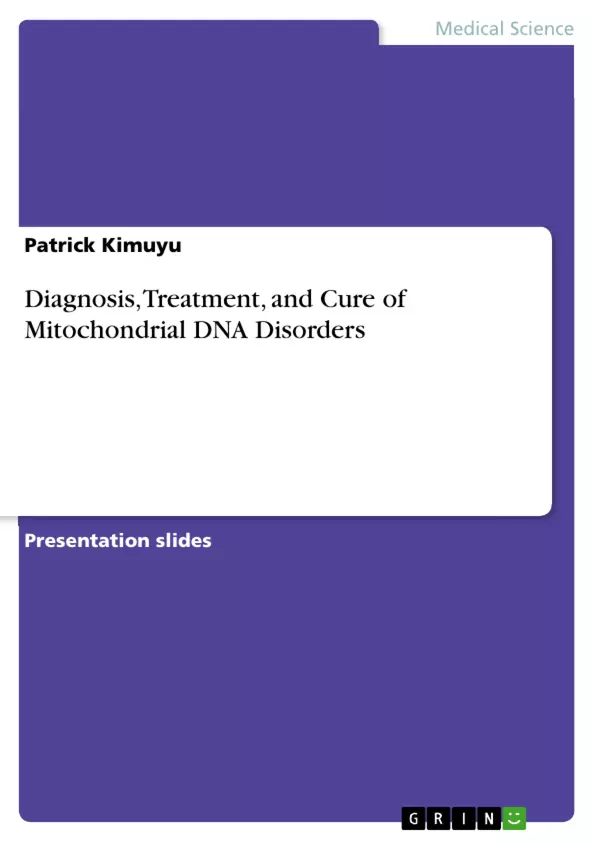Mitochondrial disorders seem to have become highly prevalent in the global population.
From a pathological perspective, mitochondrial diseases comprises of an array of clinically heterogeneous diseases.
According to Watts et al. (2014), mitochondrial mutations are inheritable and highly progressive.
These disorders are attributable to mitochondrial DNA (mtDNA) mutations, and they are manifested by the lack of cellular energy.
This pathological phenomenon has been found to be associated with defects in oxidative phosphorylation (OXPHOS).
Since the first human pathological mtDNA mutations in 1988, over 250 mtDNA mutations which are linked to different pathological consequences have been identified.
Therefore, this PowerPoint presentation provides a comprehensive overview of diagnosis, treatment and cure of mitochondrial DNA disorders.
Inhaltsverzeichnis (Table of Contents)
- INTRODUCTION
- Epidemiology of mitochondria disorders
- Mitochondria Structure and Function
- MITOCHONDRIA
- INSIDE THE MITOCHONDRION
- Anatomy of the Mitochondrion
- Membrane compartments
- Mitochondrial Genome
- Differences between mtDNA and nuclear DNA
- What causes mtDNA disorders?
Zielsetzung und Themenschwerpunkte (Objectives and Key Themes)
This PowerPoint presentation aims to provide a comprehensive overview of the diagnosis, treatment, and potential cure of mitochondrial DNA (mtDNA) disorders. The presentation explores the epidemiology, structure and function of mitochondria, the causes of mtDNA mutations, and the differences between mtDNA and nuclear DNA.
- The prevalence and epidemiological trends of mtDNA disorders
- The structure and function of mitochondria, including their role in energy production
- The causes of mtDNA mutations, including inherited and acquired factors
- The differences between mtDNA and nuclear DNA, highlighting the unique characteristics of the mitochondrial genome
- The potential for diagnosis, treatment, and cure of mtDNA disorders
Zusammenfassung der Kapitel (Chapter Summaries)
- INTRODUCTION: This section introduces the prevalence of mitochondrial disorders and their clinical heterogeneity, emphasizing the role of mtDNA mutations and their impact on cellular energy production.
- Epidemiology of mitochondria disorders: This chapter discusses the increasing incidence of mtDNA disorders, highlighting the genetic implications and providing statistical data on prevalence and incidence rates in the US and UK.
- Mitochondria Structure and Function: This chapter explores the structure and function of mitochondria, explaining their role as cellular powerhouses responsible for generating ATP energy. The section delves into the anatomy of mitochondria, including its membrane compartments, mitochondrial DNA, and the process of oxidative phosphorylation.
- Membrane compartments: This chapter details the different membrane compartments within mitochondria, focusing on the outer membrane, inner membrane, and inter-membrane space. It explains the role of cristae in mitochondrial energy conversion.
- Mitochondrial Genome: This chapter provides information about the structure and organization of human mitochondrial DNA, including its size, location, and the processes of transcription. It also discusses the differences between the light and heavy strands of mtDNA.
- Differences between mtDNA and nuclear DNA: This chapter highlights the key differences between mtDNA and nuclear DNA, focusing on their structure, size, inheritance patterns, and the presence of noncoding DNA sequences. It emphasizes the importance of understanding these differences for comprehending mtDNA disorders.
- What causes mtDNA disorders?: This section explains the causes of mtDNA disorders, attributing them to mutations in either mitochondrial DNA or nuclear DNA. It explores both inherited and acquired mutations, highlighting the role of environmental factors and cellular processes in the development of mtDNA disorders.
Schlüsselwörter (Keywords)
Mitochondrial DNA (mtDNA), mitochondrial disorders, oxidative phosphorylation (OXPHOS), epidemiology, prevalence, incidence, mitochondrial structure, mitochondrial function, mtDNA mutations, inherited mutations, acquired mutations, environmental factors, nuclear DNA, diagnosis, treatment, cure.
- Citation du texte
- Patrick Kimuyu (Auteur), 2017, Diagnosis, Treatment, and Cure of Mitochondrial DNA Disorders, Munich, GRIN Verlag, https://www.grin.com/document/381193



